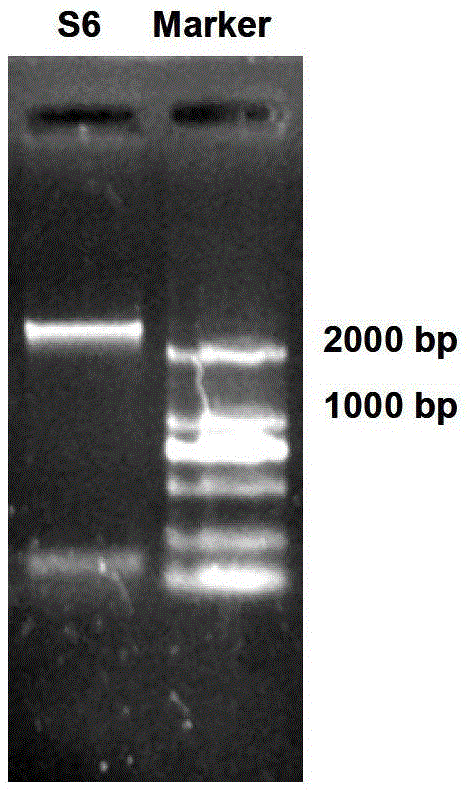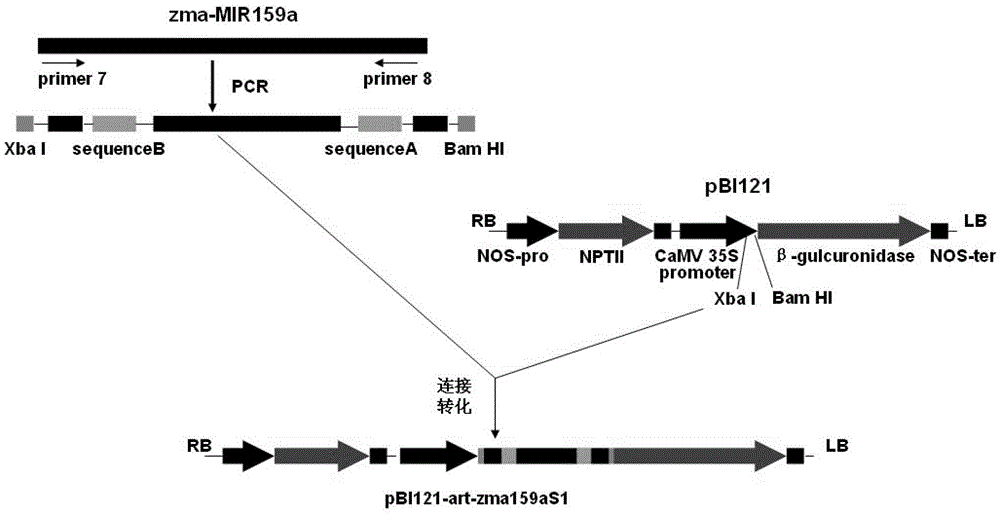The method of using artificial microrna to breed rough dwarf disease resistant corn and its special double-stranded rna
A rough dwarf disease and corn technology, applied in DNA/RNA fragments, recombinant DNA technology, botanical equipment and methods, etc., to achieve high biological safety, reduce uncertain phenotypes, and prevent and control a wide range of occurrences
- Summary
- Abstract
- Description
- Claims
- Application Information
AI Technical Summary
Problems solved by technology
Method used
Image
Examples
Embodiment 1
[0026] Example 1 Cloning of endogenous microRNA (zma-MIR159a) in maize
[0027] According to the sequence information provided by maize zma-MIR159a (accession number: MI0001809) in the microRNA database (http: / / www.mirbase.org / ), it was submitted to NCBI for blastN, and the results showed that zma-MIR159a was contained in EST (EE295085). According to the sequence of EST and the position of zma-MIR159a in EST, primers were designed primer1: 5'-AGTTCCCTCACTCCCCAG-3' (SEQNO.38), primer2: 5'-GGACGCAACAAGCAAAAA-3' (SEQNO.39), primer3: 5 '-TCGATGCTTTGGGTTTGA-3' (SEQ NO. 40), primer4: 5'-GGAGGGGTGGATCAGGAT-3' (SEQ NO. 41).
[0028] The total RNA of Qi 319, an excellent inbred line of maize, was extracted and purified, and the method was as follows:
[0029] 1. Weigh 0.2g of fresh tissue and grind it fully in liquid nitrogen until it becomes powdery. During the grinding, add liquid nitrogen slowly to prevent the material from thawing.
[0030] 2. Quickly transfer the ground tissue t...
Embodiment 2
[0049] Example 2 Obtaining the dedicated double-stranded RNA sequence for transforming microRNA
[0050] Primer5 was designed according to the sequence of genome fragment S6 of rice black-streaked dwarf virus (RiceBlack-streakedDwarfVirus, RBSDV) reported in NCBI (accession number: AJ409148): 5'-AAGTTTTTTGAGTCTGAGATA-3' (SEQNO.42 ), primer6: 5'-GACATCAGCTGATTTGAGTC-3' (SEQ NO.43).
[0051]The corn diseased leaves harmed by rough dwarf disease were collected, and total RNA was extracted. The extraction and purification methods of total RNA were the same as those in Example 1. The total RNA was reverse-transcribed into cDNA, and the reverse transcription method was the same as in Example 1, except that the oligodT primer was replaced with a random primer. Use cDNA as a template, and use primer5 and primer6 as primers to perform a PCR program. The PCR reaction program is 94°C for 5 minutes; then 94°C for 50s, 54°C for 45s, 72°C for 3min, and 32 cycles; 72°C for 7min. The PCR pr...
Embodiment 3
[0060] The construction of embodiment 3 overexpression vector
[0061] The construction process of plant expression vector is as follows: figure 2 Shown:
[0062] According to the precursor sequence of maize zma-MIR159a and the sequence of dedicated double-stranded RNA, primer primer7: TGC was designed TCTAGA TCGATGCTTTGGGTTTGAAGCG-sequenceB-AGGGTCGTTCCGAAGGG (SEQ NO. 44), and primer8: CGC GGATCC GGAGGGGTGGATCAGGATG-sequenceA-GAGAGCGGCCAGCAAGGGGG (SEQ NO.45); wherein the underlined sequence is the restriction site, sequenceA and sequenceB are the special double-stranded RNA sequence and its reverse complementary sequence. Such as sequenceA: TCATACGAGCTAAATCGACAG, sequenceB: GTCGATTTAGCTCGTATGAGA.
[0063] Using maize zma-MIR159a as template, PCR reaction was carried out with primers primer7 and primer8. The PCR reaction program was 94°C for 5 min; then 94°C for 50 s, 54°C for 45 s, 72°C for 1 min, 30 cycles; 72°C for 7 min. The amplified sequence was ligated into a T ve...
PUM
| Property | Measurement | Unit |
|---|---|---|
| molecular weight | aaaaa | aaaaa |
Abstract
Description
Claims
Application Information
 Login to View More
Login to View More - R&D
- Intellectual Property
- Life Sciences
- Materials
- Tech Scout
- Unparalleled Data Quality
- Higher Quality Content
- 60% Fewer Hallucinations
Browse by: Latest US Patents, China's latest patents, Technical Efficacy Thesaurus, Application Domain, Technology Topic, Popular Technical Reports.
© 2025 PatSnap. All rights reserved.Legal|Privacy policy|Modern Slavery Act Transparency Statement|Sitemap|About US| Contact US: help@patsnap.com



